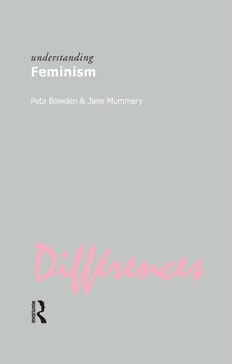
Understanding Feminism PDF
Preview Understanding Feminism
understanding feminism Understanding Movements in Modern Thought Series Editor: Jack Reynolds Th is series provides short, accessible and lively introductions to the major schools, movements and traditions in philosophy and the h istory of ideas since the beginning of the Enlightenment. All books in the series are written for undergraduates meeting the subject for the fi rst time. Published Understanding Empiricism Understanding Phenomenology Robert G. Meyers David R. Cerbone Understanding Existentialism Understanding Postcolonialism Jack Reynolds Jane Hiddleston Understanding Feminism Understanding Poststructuralism Peta Bowden & Jane Mummery James Williams Understanding German Idealism Understanding Psychoanalysis Will Dudley Matthew Sharpe & Joanne Faulkner Understanding Hegelianism Understanding Rationalism Robert Sinnerbrink Charlie Heunemann Understanding Hermeneutics Understanding Utilitarianism Lawrence Schmidt Tim Mulgan Understanding Naturalism Understanding Virtue Ethics Jack Ritchie Stan van Hooft Forthcoming titles include Understanding Environmental Understanding Pragmatism Philosophy Axel Mueller Andrew Brennan & Y. S. Lo understanding feminism Peta Bowden & Jane Mummery First published in 2009 by Acumen Published 2014 by Routledge 2 Park Square, Milton Park, Abingdon, Oxon OX14 4RN 711 Third Avenue, New York, NY 10017, USA Routledge is an imprint of the Taylor & Francis Group, an informa business © Peta Bowden & Jane Mummery, 2009 Th is book is copyright under the Berne Convention. No reproduction without permission. All rights reserved. No part of this book may be reprinted or reproduced or utilised in any form or by any electronic, mechanical, or other means, now known or hereafter invented, including photocopying and recording, or in any information storage or retrieval system, without permission in writing from the publishers. Notices Practitioners and researchers must always rely on their own experience and knowledge in evaluating and using any information, methods, compounds, or experiments described herein. In using such information or methods they should be mindful of their own safety and the safety of others, including parties for whom they have a professional responsibility. To the fullest extent of the law, neither the Publisher nor the authors, contributors, or editors, assume any liability for any injury and/or damage to persons or property as a matter of products liability, negligence or otherwise, or from any use or operation of any methods, products, instructions, or ideas contained in the material herein. ISBN: 978-1-84465-194-8 (hardcover) ISBN: 978-1-84465-195-5 (paperback) British Library Cataloguing-in-Publication Data A catalogue record for this book is available from the British Library. Typeset in Minion Pro. Contents Acknowledgements vii Introduction 1 1 Oppression 13 2 Embodiment 45 3 Sexuality and desire 73 4 Diff erences among and within women 99 5 Agency 123 6 Responsibility 151 Questions for discussion and revision 175 Further reading 177 References 183 Index 193 v contents This page intentionally left blank Acknowledgements Th is book has been generously supported through research leave, travel funding and editorial assistance provided by the University of Ballarat and Murdoch University. We are also grateful to the follow- ing colleagues, students and friends who have read chapters and pro- vided moral support during the writing process: Rose Bishop, Brodie Cooper, April Jane Fleming, Helena Grehan, Trish Harris, Niall Lucy, Nell Newman, Marnie Nolton, Dick Ounsworth, Jodi Peskett, Lorraine Sim, Sam Stevenson and Anne Surma. Kate Machin has helped us enor- mously in getting the manuscript ready for publication and Acumen’s anonymous reviewers and the Acumen editorial team, Jack Reynolds, Tristan Palmer and Kate Williams, have provided astute advice and professional assistance in the publication process. acknowledgements vii This page intentionally left blank Introduction Th e history of women’s struggle to change their lives is a long one. Th e term “feminism”, which highlights their oppression specifi cally in relation to men, however, has been in use in English only since the campaigns for women’s suff rage during the last decade of the nineteenth century. More recently, it has been the resurgence of women’s move- ments in the late 1960s – the so-called “second wave” – that is usually associated with feminist strivings for women’s equal rights, and freedom from oppressive constraints of sex, self-expression and autonomy. Most of the theoretical work of modern feminism has occurred during the period since this resurgence, and it is this work that is our focus in Understanding Feminism. Second-wave feminisms emerged in the west in conjunction with the social contestations of student protest movements, anti-war move- ments and, in the United States, the struggle for civil rights for blacks. In this they echoed earlier challenges to women’s subordination that characteristically refl ected and radically extended wider social move- ments for change. British sociologist Sheila Rowbotham’s Women in Movement (1992) traces some of these developments across the world during the period since the Enlightenment: from the struggles of women against the identifi cation of human reason and progress with the reason and progress of men during the eighteenth-century revolu- tions in America and France, and their organization for women’s rights during the movement to abolish slavery, to their mobilization on behalf of women in nineteenth-century social reform, the Russian revolution, the quest for Indian self-rule and Chinese communism. In all of these introduction 1
